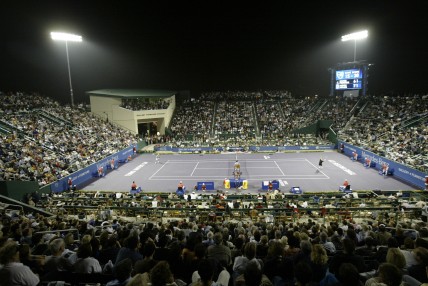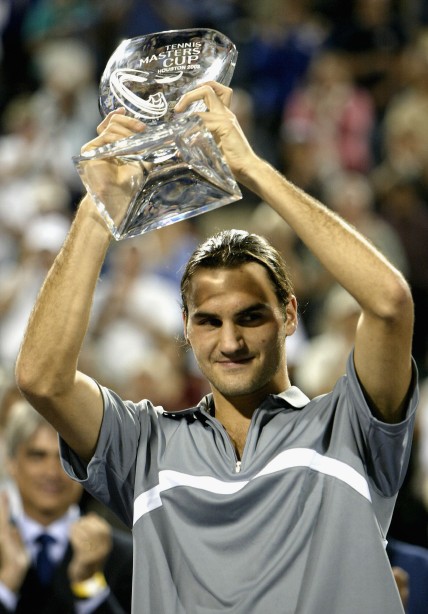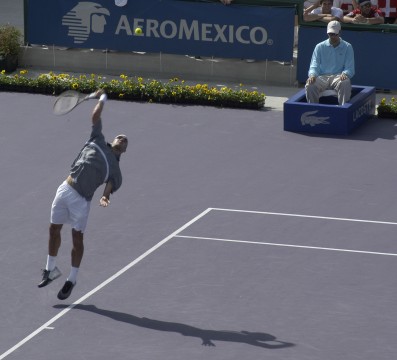Tennis Masters Cup 2003 Round Robin
Federer d. Agassi 6-7, 6-3, 7-6
Roger Federer arrived Houston in November 2003 as a relatively modest world No.3, weary after a middling indoor season, and publicly irritated with the tournament itself. He would leave as the best tennis player on Earth. Six years later he would be widely considered to be the greatest tennis player of all time. It is an audacious claim to say that this match is where it all really began, but it is not entirely without merit.
 Federer’s first Wimbledon title had of course been a triumph, and his play in the final two rounds – with resounding victories over Andy Roddick and Mark Philippoussis – was magisterial. But we’d all known that he was capable of playing like that. The question for some time had been whether he was capable of sustaining it for two weeks at a major. Indeed, our admiration for the perfection of his play was somewhat tempered by a general sentiment of ‘Well it’s about time’. The consensus in the months since was that he had now lifted to a higher level, if not of ability then of consistency. However, he had failed to fire during the US hardcourt season, and had hardly posted astounding results during the European indoor events, with a single title in Vienna and fairly soft losses in Madrid and Paris. Again, this was not unexpected. He was a streaky, brilliant player. It was the kind of effort expected of a world No.3. By contrast, Roddick and Ferrero – the world Nos. 1 and 2 – had dominated the remainder of the season.
Federer’s first Wimbledon title had of course been a triumph, and his play in the final two rounds – with resounding victories over Andy Roddick and Mark Philippoussis – was magisterial. But we’d all known that he was capable of playing like that. The question for some time had been whether he was capable of sustaining it for two weeks at a major. Indeed, our admiration for the perfection of his play was somewhat tempered by a general sentiment of ‘Well it’s about time’. The consensus in the months since was that he had now lifted to a higher level, if not of ability then of consistency. However, he had failed to fire during the US hardcourt season, and had hardly posted astounding results during the European indoor events, with a single title in Vienna and fairly soft losses in Madrid and Paris. Again, this was not unexpected. He was a streaky, brilliant player. It was the kind of effort expected of a world No.3. By contrast, Roddick and Ferrero – the world Nos. 1 and 2 – had dominated the remainder of the season.
However, Roger Federer was about to go on a hot streak that would last for four years, without pause, posting the kind of numbers that had never been seen before in the sport. So what happened? Something changed in Federer, and it occurred between arriving in Houston, and playing the final a week later. The Federer Era commenced with this tournament. It began with this match.
 I might be my imagination, but it seems like you can actually see it happening as the match progresses. Just watch Federer’s court position. In the first set he is frequently on a string metres behind the baseline, exactly where Agassi wants him. By the third set, there is none of that. Federer is now dictating play, and refusing to simply scurry about until Agassi puts him away. The shift occurs in the second set, with a series of scintillating winners that clearly give the great American pause. You can see it in Agassi’s face, in his play. He was up, he was comfortable. Now, suddenly, nowhere on the court is safe.
I might be my imagination, but it seems like you can actually see it happening as the match progresses. Just watch Federer’s court position. In the first set he is frequently on a string metres behind the baseline, exactly where Agassi wants him. By the third set, there is none of that. Federer is now dictating play, and refusing to simply scurry about until Agassi puts him away. The shift occurs in the second set, with a series of scintillating winners that clearly give the great American pause. You can see it in Agassi’s face, in his play. He was up, he was comfortable. Now, suddenly, nowhere on the court is safe.
It’s a bit like seeing Neo grow into his full powers at the end of The Matrix, as he realises that it no longer matters what his opponent’s weapons are, nor what they do with them. Federer now believed he had the shots, the confidence and the genius to bend any match to his will, to play almost any point on his own terms. From now on, the only matches he would lose would be to the very best players playing out of their skin. Anything less would be dealt with.
Federer was drawn to play in the Blue Group, which contained himself, Agassi, Juan Carlos Ferrero and David Nalbandian. (The other group, by contrast, featured Roddick, Carlos Moya, Guillermo Coria and Rainer Schuettler, a far more benign assembly.) It was a brutal assignment for the Swiss: of the three other players in his group, Federer had never beaten Agassi (0-3) or Nalbandian (0-5), and he’d lost his last encounter with Ferrero just weeks before. For his part, Agassi had a strong record against his three group-mates. He was, however, pretty short on match play. Houston was his first tournament since losing to Ferrero in the semifinal of the US Open almost two months earlier. Nonetheless, no one has ever been better than Agassi at returning from long lay-offs.
Here are some notes from the match:
- Federer’s ball striking is so fearless and uninhibited, his current form looks downright timid by comparison.
- There is much less variety and structure in Federer’s play than we are accustomed to seeing these days. Most points have an almost improvisational quality to them.
- Considering this is Agassi’s first tournament since the US Open, his level is exceptional. Actually, his level is exceptional without considering anything else at all.
- Federer attacks the net constantly, even serve-volleying with some regularity. I am reminded that he won his first Wimbledon serving and volleying, and that he returned to it in the 2004 Wimbledon final after the rain broke Roddick’s momentum.
- The point at 3/2 15-30 in the second set is probably the point of the match, and rightly earns a standing ovation. Federer’s defence is astonishing, although his capacity to transition to offence is not as devastating as it was later to become. Agassi ultimately steps in and exerts control.
- Agassi gets two bad calls on vital points in the second set. Like so many matches, the results of this match may well have been different had Hawkeye been in use. Tennis history, at least in the short term, might well have been different.
- Federer’s forehand to save the second match point in the third set tiebreak is one of the great clutch shots. As Patrick McEnroe exclaims in the ESPN coverage: “Ice in the veins.†His forehand pass to win the match is equally hair-raising.
 With that last devastating crosscourt pass, Roger Federer became Roger Federer, and commenced his ascension to the pantheon. It was his first victory over Agassi, and although they would play another seven times in the following 22 months – starting from the following Sunday – Federer would never again lose.
With that last devastating crosscourt pass, Roger Federer became Roger Federer, and commenced his ascension to the pantheon. It was his first victory over Agassi, and although they would play another seven times in the following 22 months – starting from the following Sunday – Federer would never again lose.
Federer went on to thrash Nalbandian and Ferrero in the following days, before taking out Roddick in straight sets in the semifinal. He was no longer operating on a comparable level to his opponents. The final was a much-hyped rematch with Agassi. Federer won it in a canter, 6/3 6/0 6/4. He wasn’t No.1, but he was now clearly the best player in the world.
The match can be downloaded in full here. As ever, please avoid highlights.

One Response to Great Matches You’ve Probably Never Heard Of #2